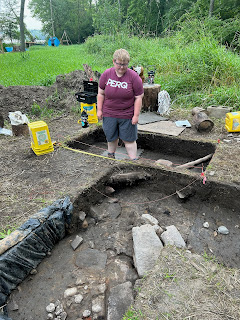Fort Followers,
A common occurrence here at the Fort St. Joseph field school is uncovering mudstone. Due to mudstone’s non-uniform shape, students new to the site can confuse it with artifacts, especially since it is made up of silt and clay. When finding mudstone, especially red or orange colored mudstone, it can be mistaken for a piece of dried or baked clay. Mudstone can sometimes appear to look “flaked” or “chipped” at, so a new archaeologist in training might think it could be a flint flake or even a projectile point. My classmates and I come across mudstone often and at first believed it to be other things. As a result, I thought it would be fun to research and write about what it is.According to the University of Auckland’s Geology page, mudstone is a sedimentary rock made of silt and clay. It describes mudstone as presenting itself in various colors like brown, black, red, grey, etc. We have mudstone at the Fort in all these colors, including some that look more orange than brown. From the website, World of Stones, it is described that when finding mudstone that is black or grey, it suggests that there is organic content. The organic content typically is due to natural gases and oils. If you were to find green, brown, red, or yellow mudstone, this would indicate the existence of iron oxide in the stone.
World of Stones contains more information including that the chemical compound of mudstone is NaCl, CaO, Aluminum Oxide, Iron (III) Oxide, and much more. According to the website, mudstone can be located all around the globe. Continents that have mudstone include Europe, Asia, Africa, the Americas, and Australia. Mudstone is typically located near waterways, which makes sense because we are located right next to the St. Joseph River. There is also a lot of clay and silt in the river, which helps to be responsible for the creation of mudstone.Now you may be asking yourself, “Is mudstone important?” or “Can mudstone be used for anything?”, The Geological Society helped provide me with that answer, YES! On their page, the Rock Cycle, they include mudstone being used for pottery, cement, brick roofs, and tiles. Going back to the World of Stone, they wrote that mudstone could be used as a stone veneer, pathways, stepping stones, tiles, etc.
When excavating at Fort St. Joseph, finding mudstone can be disappointing when it comes to wanting to find 18th-century artifacts. But when looking at mudstone from a different view, it is really cool. I find it really intriguing that mudstone can look completely different from each other, but be considered the same thing. It is really neat that nature makes these odd but pretty-looking rocks.
The 2023 Fort St. Joseph field school will not be the last to uncover mudstone at the site or in the world. But I am hoping that by reading this blog, people will have a better understanding of what mudstone is and that it isn’t just a “stone”.
Korrin
References:
“Mudstone Uses.” The Geological Society, www.geolsoc.org.uk/ks3/gsl/education/resources/rockcycle/page3528.html. Accessed 14 Aug. 2023.
“Mudstone – Meaning, Uses, Facts, Properties & Color.” WorldofStones, worldofstonesusa.com/blogs/all/mudstone#:~:text=Chemical%20Properties,Silicon%20Dioxide%2C%20and%20so%20on. Accessed 14 Aug. 2023.
“Mudstone.” Geology - Rocks and Minerals, rocksminerals.flexiblelearning.auckland.ac.nz/rocks/mudstone.html#:~:text=Mudstone%20is%20an%20extremely%20fine,clay%20and%20silt%2Dsized%20particles. Accessed 14 Aug. 2023.












